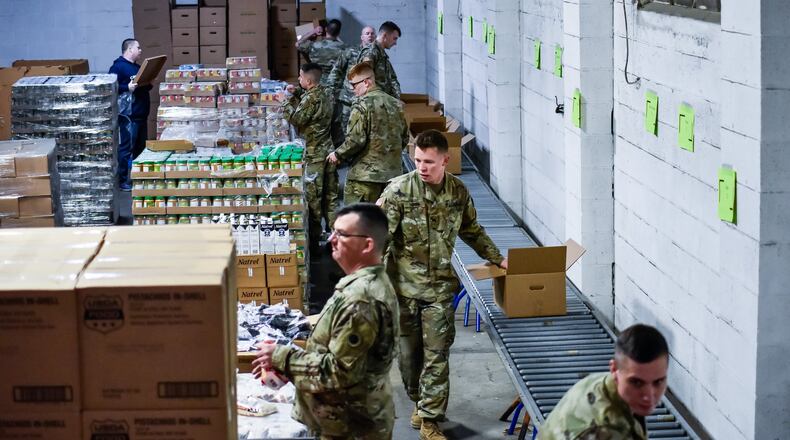“As long as people are concerned about exposure, which reduces available volunteers, and unemployment is high, which results in more people needing help with food, we need the additional support from the National Guard,” said Shared Harvest Foodbank Executive Director Terry Perdue. “Without the National Guard, we would not be able to maintain our mass distributions which helps relieve the strain on local food pantries, soup kitchens, and shelters that we serve.”
As of Friday, guardsmen working at Shared Harvest on Ohio 4 in Fairfield packed more than 1.1 million pounds of food and delivered more than 525,000 pounds directly to distribution sites that supported 14,338 people in 9,900 households from Butler, Darke, Miami and Preble counties.
If the federal money doesn’t come, DeWine spokesman Dan Tierney said “funding for their missions will continue.”
“(The Ohio Office of Budget and Management) would consider all possible applicable ways to fund this continuing critical need, including the state’s Coronavirus Relief Fund, because it is crucial that the missions continue,” Tierney said.
The Ohio National Guard has helped distribute more than 33 million pounds of food across the state. As of Friday, none of Ohio’s food banks have been formally notified by DeWine or his administration about an extension of the National Guard’s mission, said Joree Novotny, spokeswoman for the Ohio Association of Foodbanks.
“We’re encouraged by his remarks, and this is something that’s been fluid since Day 1,” she said. “We just haven’t gotten official word of that.”
DeWine called up the Ohio National Guard in March to assist food banks with distribution as demand skyrocketed along with unemployment numbers during the pandemic. The governor signed another order in late May to have guardsmen assist skilled nursing facilities with collecting samples to be tested.
Ohio Health Care Association Executive Director Peter Van Runkle said the National Guard’s role in testing at skilled nursing facilities will change starting Tuesday “and will gradually phase out.”
On Friday, guardsmen wrapped up the last of the baseline testing in the state, he said, and when the second round of tests begin Tuesday, instead of National Guard members collecting swabs, facility personnel will do so. Guardsmen will courier the collected samples to a lab for testing, Van Runkle said.
“They won’t actually be stepping foot in the buildings, they’ll just be stopping by,” he said. “It’s a different role because they decided it would be better to have the facility staff do the swabbing — it’s not a complex procedure — as a more efficient way of getting it done than having to send out swab teams.”
Nearly 1,200 Ohio guardsmen have been activated to respond to the COVID-19 pandemic across the state. Federal funds expire on Aug. 21, but that accounts for a two-week quarantine period for guardsmen, so without state funding, or authorizing the state’s portion of the CARES Act to continue the National Guard’s mission, guardsmen will return home after Aug. 7.
In support of DeWine’s request, a majority of Ohio’s congressional delegation requested in a July 24 letter from the Federal Emergency Management Agency and U.S. Department of Defense emphasizing the need for additional funds.
“COVID-19 has continued to create significant and unprecedented challenges for state and local governments, businesses, individuals and families in Ohio,” the letter reads. “As you know, state and local governments do not have the capacity to sufficiently respond to this major disaster.
The letter is signed by Ohio Sens. Sherrod Brown and Rob Portman, and 13 of the state’s 16 members of Congress.
READ MORE
Read the letter sent to FEMA and the U.S. Department of Defense asking for additional federal funding to support the Ohio National Guards mission as the state battles the novel coronavirus, COVID-19.
ONG Title 32 Letter to FEMA... by Michael D. Pitman on Scribd
About the Author

